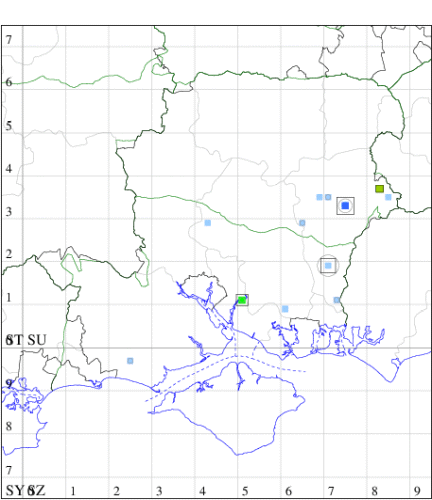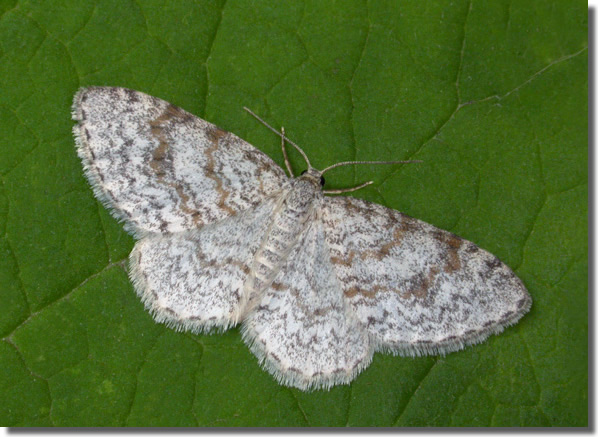Waved Carpet
Hydrelia sylvata
Checklist Number70.113 [B&F: 1877]
Verification
Record will require further evidence, at least a good photograph, unless CMR is aware recorder has confidence in identification
Classification
| Family: | Geometridae |
| Subfamily: | Larentiinae |
| Genus: | Hydrelia |
| Species: | sylvata |
| Authority: | ([Denis & Schiffermüller], 1775) |
Nationally scarce (Nb) in woodland, scrubby heathland and on sea cliffs in southern England and Wales. Has decreased in numbers considerably since coppicing went out of favour, but does appear to be expanding its range in Sussex. In Hampshire appears sporadically at sites such as Oxenbourne Down and Swanwick HWT, but does not seem to survive in any one site for more than a few years. Not recorded from the Isle of Wight to date. Wingspan 27-30 mm. Welsh Wave Venusia cambrica is superficially similar, but Welsh Wave has a more clearly demarcated pale central band which is bordered by thin black fascia. Larva feeds on Sweet Chestnut, Alder, Downy Birch, Silver Birch and Sallow, over-wintering as a pupa.


The abundance in each month is indicated as follows:
 No records
No records Very occasional
Very occasional Irregular
Irregular Uncommon
Uncommon Off-peak, but not unusual
Off-peak, but not unusual Off-peak, but not unusual
Off-peak, but not unusual Main flight time
Main flight time| J | F | M | A | M | J | J | A | S | O | N | D | |
|---|---|---|---|---|---|---|---|---|---|---|---|---|
| Adult |  |  |  |  |  |  |  |  |  |  |  |  |
| Larval |  |  |  |  |  |  |  |  |  |  |  |  |
Records by week (adult)
Records by week (larval)
VC11 South Hampshire
| Site | Date | Quantity | Recorder | Stage |
|---|---|---|---|---|
| Crab Wood, Winchester (SU42) | 1800 | - | Unknown | - |
| Rowlands Castle (SU71) | 1900 | - | F C Stanley | - |
| Southwick (SU60) | 01/06/1911 | - | Robinson | - |
| Oxenbourne Down (SU71) | 06/07/1964 | - | E A Sadler | Adult |
| Bashley (SZ29) | 21/07/1969 | - | Laurence Evans | - |
| Oxenbourne Down (SU71) | 09/07/1973 | one | Richard J Dickson | Adult |
| Oxenbourne Down (SU71) | 05/07/1975 | one | Richard J Dickson | Adult |
| Oxenbourne Down (SU71) | 05/07/1975 | - | John R Langmaid | Adult |
| Swanwick HWT NR (SU51) | 06/07/2001 | one | Martin C Harvey | Adult |
VC12 North Hampshire
| Site | Date | Quantity | Recorder | Stage |
|---|---|---|---|---|
| Waggoners Wells (SU83) | 1800 | - | Unknown | - |
| West Tisted (SU62) | 1900 | - | E A Sadler | - |
| Butser Hill (SU71) | 06/07/1964 | - | E A Sadler | - |
| Farringdon (SU73) | 10/07/1967 | - | E A Sadler | - |
| Butser Hill (SU71) | 1973 | - | David M Appleton | - |
| Selborne (SU73) | 20/07/1995 | one | Alasdair Aston | Adult |
| Selborne (SU73) | 16/07/1996 | one | Alasdair Aston | Adult |
| Headley (SU83) | 16/07/2016 | one | Anthea L Lockley | Adult |
| Hammer Vale, Woolmer (SU83) | 20/07/2024 | one | Andy Swan | Adult |



